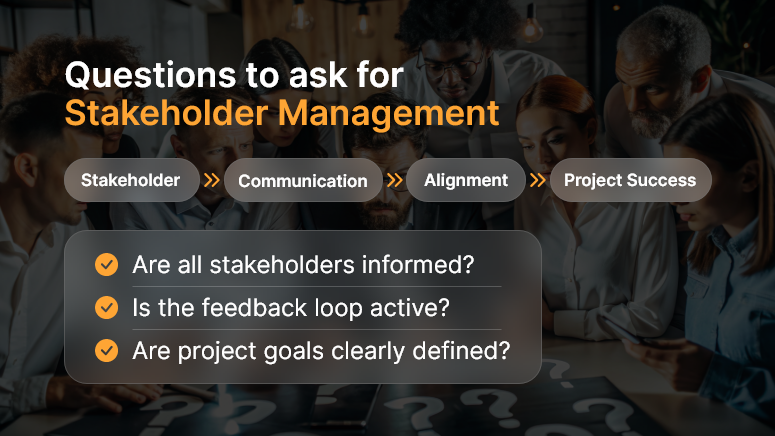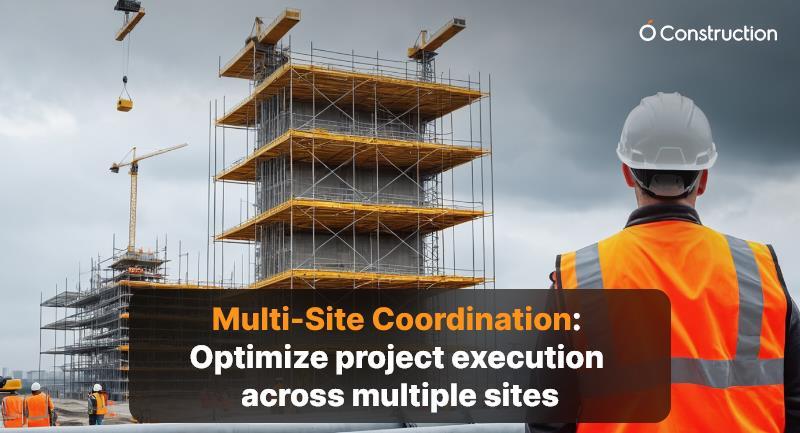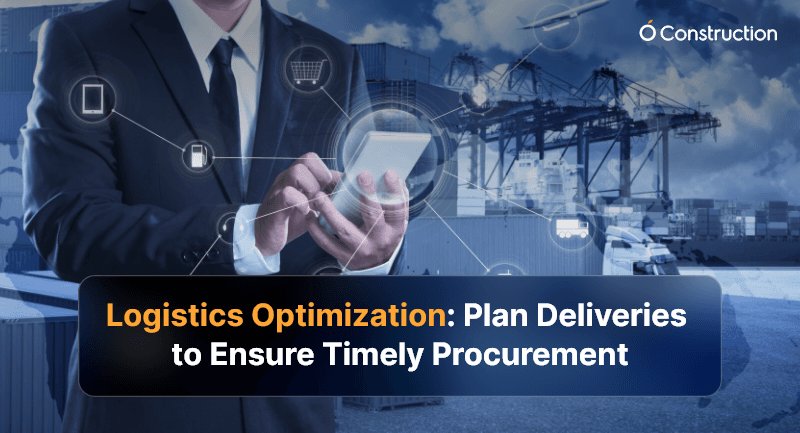The success or failure of a project often hinges less on technical execution than on how well stakeholders are managed. Stakeholders—whether clients, team members, vendors, local communities, regulatory agencies, or end users—carry expectations, influence, and sometimes conflicting goals.
Stakeholder management is the art and practice of identifying, engaging, communicating with, and aligning all parties so that the project proceeds smoothly, conflict is minimized, and value is delivered.
In this blog, we explore key principles, steps, challenges, and strategies for stakeholder management—so you can keep everyone on the same page throughout the project lifecycle.

Why Stakeholder Management Matters
Let’s start with why stakeholder management is not just “nice to have” but critical:
- Alignment of expectations: Misaligned expectations lead to scope creep, disputes, or dissatisfaction.
- Risk mitigation: Unheard stakeholders may raise objections, delays, or resistance midstream.
- Better decision-making: Stakeholders often hold valuable insights, constraints, or feedback that improve outcomes.
- Trust and buy-in: When people feel included and informed, they are more supportive and cooperative.
- Conflict reduction: Proactive communication and transparent decision paths help reduce surprises and confrontations.
- Smoother change management: When changes are necessary, good stakeholder relationships ease acceptance.
In construction projects, for example, Public notes that “indirect stakeholders” (residents, shop owners, political groups) often get overlooked in favor of direct ones (clients, contractors), but their influence can make or break the project’s public perception and regulatory compliance.
That principle holds in nearly all domains: it’s not enough to focus only on parties who deliver or receive the project’s outputs; you must also manage those impacted.
The Stakeholder Management Lifecycle
A robust stakeholder management approach can be organized in phases:
- Identification & Mapping
- Analysis & Prioritization
- Engagement Strategy & Planning
- Communication & Interaction
- Monitoring, Feedback & Adjustment
- Post-Project Review & Improvement
Let’s unpack each phase.
1. Identification & Mapping
What to do:
- List all potential stakeholders (internal and external).
- Include direct participants (e.g., clients, team, vendors) and indirect ones (e.g., regulators, communities, media, neighboring businesses, interest groups).
- Build a stakeholder map or visual (flowchart, matrix, network diagram) showing relationships, influence, roles, and interactions.
- Regularly revisit and update this map — stakeholders may emerge, shift in influence, or drop off.
- Public emphasizes that stakeholder mapping must be repeated regularly, because new stakeholders may appear, priorities change, and risk profiles shift.
Tips:
- Use frameworks like the impact/influence matrix (e.g., high-influence / high-interest quadrant)
- Use tools such as stakeholder maps, stakeholder registers, and entity-relationship diagrams
2. Analysis & Prioritization
What to analyze:
- Influence or power (how much a stakeholder can affect the project)
- Interest or stake (how affected they are by the project)
- Attitude (supportive, neutral, resistant)
- Risks or issues they may pose (delays, objections, negative press)
- Dependence relationships (who is dependent on whom)
- Needs, concerns, and expectations
How to prioritize:
- Focus more resources on high-power, high-interest stakeholders
- Identify “watch” group (high power, low interest) and “keep informed” group (low power, high interest)
- Balance across stakeholder groups so no key stakeholder feels neglected
3. Engagement Strategy & Planning
Once you know who matters most and what their concerns are, decide how, when, and how much to engage them.
Key components:
- Communication channels and frequency (meetings, newsletters, workshops, town halls, social media, one-on-one)
- Tone, content, and format depend on stakeholder type and literacy
- Two-way engagement, not just broadcasting: include mechanisms for input, feedback, grievance redressal
Escalation and issue resolution paths - Roles & responsibilities: who in your team is responsible for stakeholder relationships
- Governance & access control: who sees what information, when, and who can respond
In the Public example, their tool allows defining what each stakeholder sees and who can interact with whom, ensuring access control and relevance.
4. Communication & Interaction
This is the execution phase: implementing your engagement plan.
Best practices:
- Be transparent: Even the bad news. Publish schedules, explain “why,” and explain what you’ll do to mitigate negative impacts. Public gives the example of informing residents in advance about noise, pollution, scheduling, and mitigation efforts.
- Communicate clearly and concisely: Use language the stakeholder understands. Avoid jargon when talking to non-technical audiences.
- Regular cadence: Consistency builds trust — weekly or monthly updates, standups for the core team, newsletters for the broader group.
- Tailor messages: Different stakeholders have different needs. A subcontractor may want technical details; a community group needs a high-level schedule, impact, and mitigation steps.
- Active listening: Provide mechanisms for suggestions, complaints, and feedback. Don’t ignore or dismiss them.
- Respond respectfully: Even negative or unreasonable complaints merit proper replies. Sometimes an apology or clarification goes a long way.
- Facilitate stakeholder interactions: Encourage dialogue, co-creation, and joint problem solving.
5. Monitoring, Feedback & Adjustment
Stakeholder management is not “set and forget.” You must continuously monitor, evaluate, and refine your approach.
- Track engagement metrics: response rates, sentiment, escalation frequency
- Monitor risks or dissatisfactions emerging from stakeholders
- Update your stakeholder maps and priority lists as conditions change
- Adjust communication frequency, content, or format based on feedback
- Document lessons learned and evolve engagement strategies
6. Post-Project Review & Improvement
Once the project is done, close the loop:
- Conduct stakeholder debriefs: What worked? What didn’t?
- Collect stakeholder satisfaction surveys or feedback
- Document best practices and improvement areas
- Feed them into your organization’s process library so future projects benefit
As the Public says, “When every construction project comes to an end, you transfer these experiences to future endeavours.”
Common Challenges & How to Overcome Them

Real-World Examples & Illustrations
- Construction & Infrastructure: As in the Public example, when construction causes noise, dust, and road closures, residents may be negatively impacted. Transparent scheduling, mitigation planning (like dust suppression, work hours, alternate routes), and proactive announcements can reduce complaints and local resistance.
- Urban Redevelopment / Infrastructure Projects: Local businesses, commuters, environmental activists, municipal agencies—each must be engaged, informed, and sometimes compensated.
- IT / Software Projects: Stakeholders include customers, sponsors, regulatory bodies, internal users, and third-party integrators. Managing expectations about feature scope, cutover plans, downtime, and data migration is critical.
- Product Launch / Consumer Goods: External stakeholders may include media, influencers, end-users, and regulatory authorities. Early beta users’ feedback becomes critical.
- NGO or Social Projects: Communities, donors, local government, and beneficiaries all have stakes in outcomes, transparency, and inclusiveness.
In each case, the principles (mapping, transparency, two-way communication, iteration) apply.
Tips & Best Practices
- Start early – don’t wait until problems arise to engage stakeholders
- Use stakeholder personas – treat groups with similar needs as a “persona” to tailor messaging
- Use multiple channels – email, meetings, apps, dashboards, social media, town halls
- Visual dashboards – for those who like quick overviews (Gantt, status RAG, heat maps)
- Structured feedback loops – surveys, Q&A sessions, suggestion boxes
- Governance forums – advisory boards, steering committees, where stakeholders can participate in decisions
- Neutral facilitators – when tensions exist, use a mediator or third party to facilitate dialogue
- Document every interaction – keep records of communications, concerns, decisions
- Balance visibility vs confidentiality – some data is sensitive (bids, budget); gate who sees what
- Empathy & respect – treat dissenting voices with dignity, acknowledge concerns, even if you cannot satisfy them fully
Sample Stakeholder Management Plan Outline
Here’s a template you can adapt:

Conclusion
Stakeholder management is not a peripheral activity — it’s central to project success. A project might have the best technology, schedule, or budget plan, but if key stakeholders feel ignored, misled, or antagonized, delays, pushback, or failure can ensue.
By systematically identifying, prioritizing, engaging, and adapting to stakeholders — with transparency, clarity, and responsiveness — you can keep everyone on the same page. That alignment helps reduce surprises, build trust, and enable smoother execution.
Would you like me to create a shorter “blueprint” or slide deck summary of this for your blog or presentation?
FAQs
1. What is stakeholder management in projects?
Stakeholder management is the process of identifying, analyzing, engaging, and communicating with individuals or groups who are affected by or can influence a project. It ensures expectations are aligned and conflicts are minimized.
2. Why is stakeholder management important?
Without proper stakeholder management, projects risk misaligned expectations, delays, conflicts, or even failure. Effective engagement builds trust, improves decision-making, and helps gain support from all parties.
3. Who are considered stakeholders in a project?
Stakeholders include anyone with a direct or indirect interest in the project: clients, project teams, vendors, investors, regulatory agencies, local communities, and even end users.
4. What is stakeholder mapping?
Stakeholder mapping is the process of visually identifying stakeholders, their level of influence, and their interest in the project. This helps prioritize engagement efforts and ensures no key stakeholder is overlooked.
5. How do you prioritize stakeholders?
Stakeholders are typically prioritized based on their power (influence) and interest (level of impact). High-power, high-interest stakeholders require the most attention, while others may simply need to be kept informed.
6. What are common challenges in stakeholder management?
Some challenges include hidden stakeholders emerging later, conflicting demands, resistance to change, communication breakdowns, and low engagement from certain groups.
7. How to manage conflicts between stakeholders?
Conflicts can be reduced by open communication, transparency, and negotiation. If disagreements persist, use governance structures (like steering committees) or neutral facilitators to resolve disputes.
8. How often should I update stakeholders?
The frequency depends on the stakeholder’s role and influence. Core team members may need daily or weekly updates, while external stakeholders may only require monthly progress reports or milestone reviews.
9. What tools can help in stakeholder management?
Tools include stakeholder registers, RACI charts, communication plans, project dashboards, feedback surveys, and specialized project management software that controls access and communication.
10. How can organizations improve stakeholder engagement over time?
By conducting post-project reviews, gathering feedback, documenting lessons learned, and refining communication strategies, organizations can build stronger stakeholder relationships for future projects.



